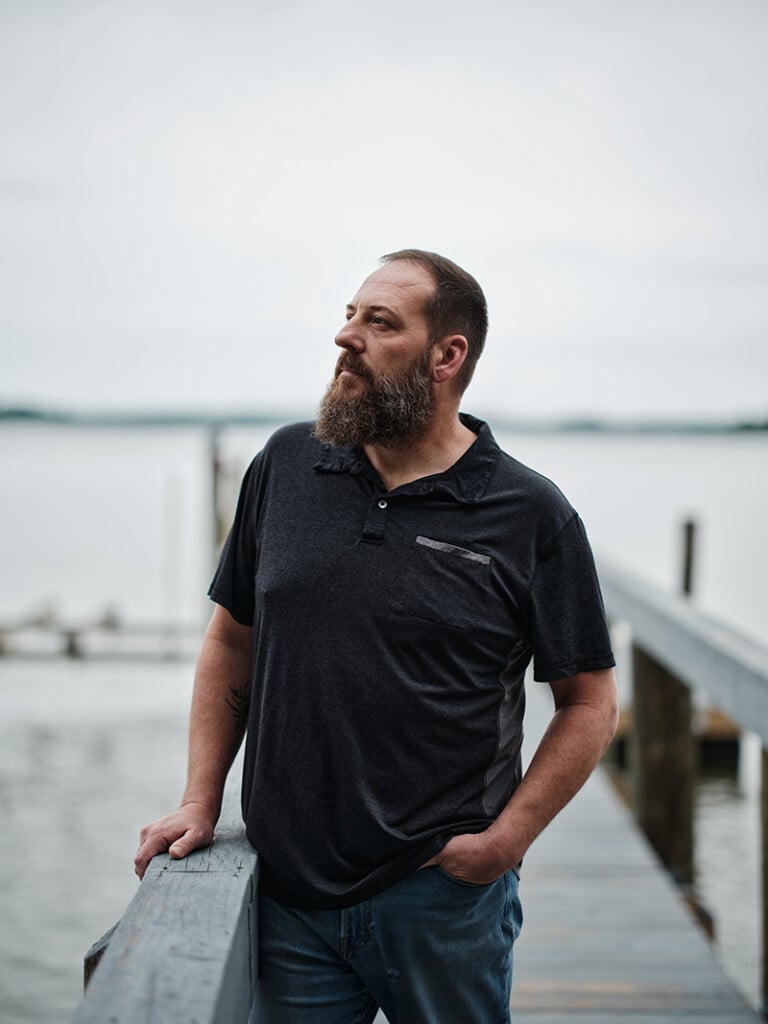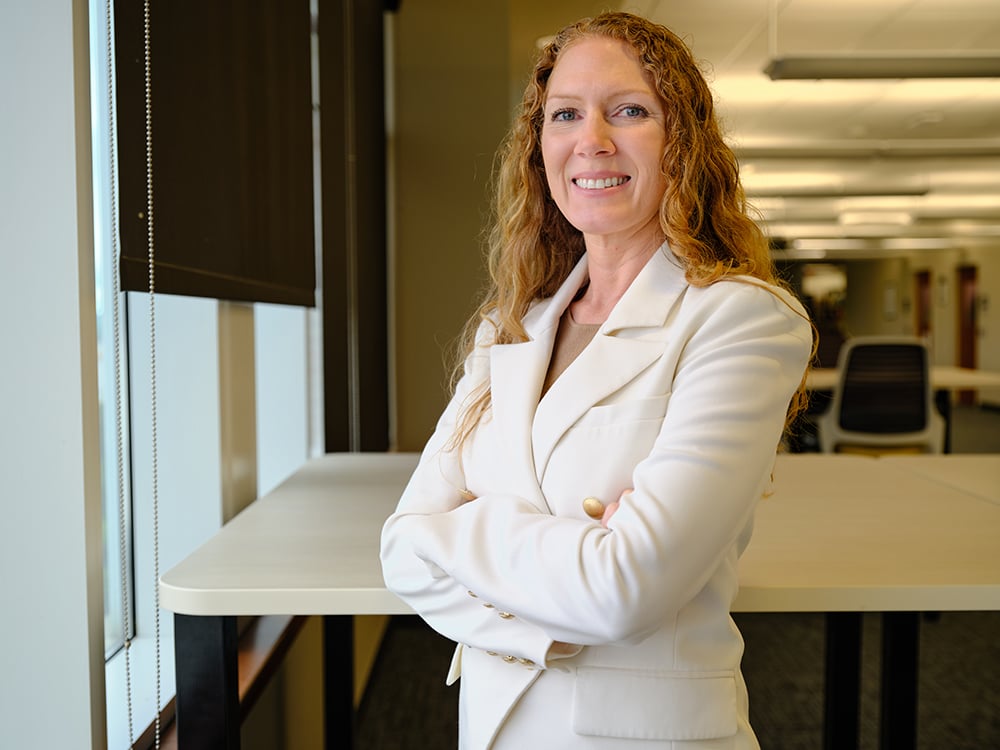A Rare Disorder That Emerged From Nowhere Nearly Killed This Lake Wylie Man
Rob Marchand has fought his way toward the light

Ten days into his hospitalization—after he’d resisted the wheelchair, after he’d twice walked out of the hospital, even after he’d suggested that an Uber would be cheaper than the airlift helicopter needed to save his life—Rob Marchand put up another fight. He wanted to see his daughters. No more treatments until he saw his kids. “You can’t tell me that I have to sit here and fight for my life,” he told his doctors, “when I can’t see what I’m fighting for.”
It was Sunday, Jan. 8, 2023. Rob had started to feel ill in the days leading up to Christmas, having already contracted COVID over Thanksgiving. He thought this was a recurrence—the symptoms were similar—and went to an urgent care center, which tested him. Negative. They gave him steroids and sent him home.
It got worse. He began to snap at his partner, Beth, and his daughters. By New Year’s Eve, he couldn’t get out of bed or keep anything down. His abdominal pain was excruciating. That morning, Beth told him: Look, whatever you have, you’re going to die if you don’t get fluids. They drove from Rob’s home, then in Fort Mill, to the emergency room at Atrium Health Pineville, about 20 minutes away.
Ten days later, having come within hours—”if that”—of death and endured multiple plasma exchanges to fix what was wrong with his blood, Rob needed to see Ali and Lexsi, his daughters from a marriage that had ended. They came, of course. But after his explosions over the holidays, the girls didn’t know which version of their dad they’d see. They met him at the Panera Bread in the lobby at Atrium Health Carolinas Medical Center.
“I remember being really nervous, because I hadn’t seen him since he lashed out at me, and even when I had called him, he was kind of just out of it,” says Ali, now 16; Lexsi turns 12 this month. The girls, Rob, and I sit at a scuffed wooden table at the home they share with Beth and her three children on Lake Wylie. It’s a sunny afternoon in April, and a gentle breeze ripples the water. “Then, when I did see him … you know, like, when you first see somebody after it’s been so long, you think it’s going to be really weird and awkward, but then it’s not? When I looked at him, I could see that it was more him and not the way he was before.”

Rob, Beth, and their children live in Lake Wylie. Rob’s daughter Lexsi is at far left, and Ali is next to her.
Something had changed for good, though.
“That,” Ali says, “was the first time I’d ever seen him cry.”
Along with many other things, his inability to cry is no longer an issue. He demonstrates that definitively, right here at the table. “Oh, yeah,” he says. “I do a lot of it.” The tears keep coming, as they did at the Panera. “I missed you guys.”
It’s all different now. Before, Rob was a robust man who had lettered in five sports in high school. He smoked a pack of Marlboro Lights a day. He was logical and math-oriented, just settling into a job at Octapharma Plasma, the Charlotte subsidiary of a global company based in Switzerland. He was still recovering from his divorce and, while his year-old relationship with Beth showed promise, neither had fully committed. He took no prescription medications. “I was on nothing, not baby aspirin, I mean, nothing,” he says. “I didn’t take supplements. I ate Doritos all the time, and I loved them, and I thought, They can’t be that bad, because they sell them. I’ve learned a lot since then.”
Now, at 47, Rob knows how unpredictable life and disease can be. He’s quit smoking and Doritos and made other changes to his diet. A man who once believed the world worked like math—a+b=c, no matter what—now accepts that medicine doesn’t work that way, and neither does life. “There are things I’m not meant to understand,” he says. He knows what it’s like to be the subject of a short film. He knows that life, random as it can be, is also full of wondrous coincidences, like this one: The company he’d just begun to work for exists to acquire the very thing that, six months later, saved his life.
Most of all, he knows he’s where he needs to be, and with the people he needs to be with. That, at least, struck him full force that day in January 2023. “It was a lot of crying, a lot of hugging. I mean, some of the pictures, they’re like, ‘Oh, my God, stop.’” He chuckles through sobs. “I know they were scared. I was scared. It was very comforting just to hold them again.”
A century before, on Labor Day 1923, a teenage girl in New York City had gone swimming at Rockaway Beach in Queens. Four months later, she was admitted to Mount Sinai Beth Israel Hospital with a 104-degree fever, pallor, severe anemia, and petechiae, tiny spots on the skin caused by bleeding from small blood vessels. Within a few days, she slipped into a coma and died. The doctors who treated her “were convinced that they were dealing with a new disease,” the hospital pathologist later wrote. It took decades for the condition to acquire its final, cumbersome name: thrombotic thrombocytopenic purpura, or TTP.
When we bleed, platelets rush to the wound. They latch onto blood vessel surfaces and strands of protein called von Willebrand factor, and clots begin to form. But if the clumps of platelets and protein strands grow too large and adhesive, they inhibit blood flow throughout small blood vessels. So other proteins—ADAMTS13 enzymes, found in plasma—act like pruning saws: They trim the von Willebrand factor proteins so they can easily circulate.
When the body lacks enough ADAMTS13 enzymes, the von Willebrand factor proteins stay too big and sticky. The large complexes of proteins and platelets clump and create small clots in organs everywhere. That’s what causes TTP, which affects about five out of every million people. The condition can be hereditary or touched off by an illness that causes the immune system to produce antibodies that stifle the enzymes. It can happen without warning. People with TTP can experience fever, nausea, and vomiting, extreme tiredness, and jaundice, and their bodies may form petechiae or purpura, larger areas of bleeding under the skin.
Doctors at Atrium Pineville suspected TTP soon after Rob arrived on New Year’s Eve 2022. But they couldn’t confirm it at first. The uncertainty infuriated an already confused Rob, a mathematician who worked in donor fee strategy at Octapharma and thought medicine was as straightforward as his job. “I remember thinking, These guys are doctors. They went to school a lot longer than I did. They’re supposed to be way smarter than me, and they don’t have an answer,” he says. “That bothered me a lot.”
TTP symptoms don’t show up the same way for everyone. Rob—though “very, very sick,” says Dr. Mary Ann Knovich, who would soon become his hematologist—hadn’t manifested a symptom that clearly signals its presence. “He had an atypical presentation of an unusual disease,” Knovich says, “and that combination made it more difficult for the (doctors) who originally saw him.”
They tested Rob’s blood and looked for schistocytes, red blood cells that would have been damaged when they encountered the multitude of clots. The doctors saw few schistocytes under the microscope the first two days at Atrium Pineville. On Jan. 2, they saw a slew of them. “The result of that test was that my red blood cells were being destroyed,” Rob says. “They were being completely ripped apart.”

Dr. Mary Ann Knovich, a hematologist at Atrium Health Carolinas Medical Center, helped diagnose Rob’s illness and continues to monitor his blood enzyme and platelet levels. She and other doctors can only theorize how Rob developed TTP: “We don’t have a perfect retrospectoscope.”
And that meant he had to go to Carolinas Medical Center to have his defective blood plasma replaced—not in a week, not in a day, not when a rideshare could pick him up and drive him there, but by helicopter, now.
Jaundice was setting in; Rob’s skin and eyes had turned yellow. He remembers nothing about the airlift. The six plasma exchanges he endured over the next 11 days made an impression, though. During each procedure, his blood was gradually removed and placed in a centrifuge that separated the plasma from blood cells. Then it was replaced with fresh plasma, and his blood was recombined and injected back into him. “And it’s very cold,” he says. “I mean, they bring (plasma) in frozen, and they don’t warm it up. They just give you an extra blanket.” Over time, whatever had caused his ADAMTS13 enzyme deficiency cycled out. He began to improve. His personality and memory resurfaced.
By then, Knovich had joined his treatment team. She has more than just a professional interest in TTP. When she was in high school in Pennsylvania in the early 1980s, she helped care for the children of a cousin of hers who’d received a TTP diagnosis in an era when it was practically a death sentence. Doctors had just begun to use plasma exchange to treat it, and the procedure saved Knovich’s cousin, now in her 70s with four children and 16 grandchildren. The experience led Knovich to make a career out of treating blood disorders.
“I was young and impressionable at that age,” she says, “so, for me, it’s very, very personal.”
The doctor, in other words, understood that treatment of TTP involved more than blood tests and enzymes and plasma exchanges. It was Knovich who agreed when Rob told her: I need to see my kids.
Rob went home four days later and back to work a few days after that. At the office, his brain fog lingered for months. “I could still do the job,” he says, “but it took two, three, four times longer than it used to.” He’s gradually recovered, although he’s still not where he was before TTP.
His supervisors have been patient. Rob’s experience coincided with a deliberate culture change at Octapharma Plasma, the American subsidiary headquarters of a Swiss company that collects plasma in the United States and offers products in 118 countries. It develops medicines in hematology, immunotherapy, and critical care. The Charlotte location was established in 2007 to operate the company’s U.S. plasma donation centers, which numbered more than 180 as of April.
In 2022, Octapharma Plasma rebranded to highlight the stories of beneficiaries to potential donors. The company decided to change its internal culture, too. “If we rebrand to the public, we have to rebrand as an organization,” says Breanne Byrne, Octapharma Plasma’s marketing director. “We’re people first.”
Rob’s story matched the message the company wanted to send to donors: This is the difference a plasma donation can make in one person’s life, and this person happens to work for us. He agreed, and Octapharma Plasma released an 8-minute video, The Rob Marchand Story, to coincide with Bleeding Disorders Awareness Month in March. It’s the work of Stone Hill, a 31-year-old producer and director hired in 2024, and is available on YouTube.
“Rob’s a popular guy,” Byrne says with a chuckle. “The posts around his video have outperformed every other post we’ve ever done across all of our social platforms.”
Rob still marvels over the coincidence, which he concedes seems hard to believe. “The irony is not lost on me,” he says, laughing in disbelief. “If I ever thought there was such a thing as a coincidence before, I certainly don’t now. There is a higher plan, and I am just part of it, and it is not for me to decide.”
When he got back home, Rob didn’t feel like a social media celebrity. For one thing, he had to inject himself—every day for a month—with a drug, Cablivi, that controls clotting and boosts platelet production. He had to inject the needle into his belly. He hates needles. “That was not fun,” he says. He had to take medication to repair the damage TTP had done to his heart. At one point, he told his doctors that he wanted to stop. His cardiologist’s response: “Please don’t do that.” He still had to regularly see Knovich, who continues to monitor his ADAMTS13 and platelet levels. “I started doing yoga,” he says, “which is hard, a lot harder than I thought it was going to be.”
This was the hardest part: Patching things up with his girls and Beth. It wasn’t so hard for them—they understood that he wasn’t himself when he acted like a jerk—but Rob felt guilty. Let’s watch a movie, he’d tell Ali and Lexsi. Let’s take a ride to the store.
“He was kind of, like, kissing up a little bit,” Ali says at the table in Lake Wylie.
“Not ‘kissing up,’” Rob says with a grin. “‘Trying to mend.’”
“No,” Ali replies, “you were kissing up.”
Beth was even harder. He was toughest on her during his illness. In retrospect, Rob thinks that, given his recent divorce, he was subconsciously pushing Beth away to avoid hurting himself and her. (Beth requested that her last name not be used in this article.) She kept urging him to do the things she knew would save him—go to the emergency room, take the medication, get on the damn chopper—and he kept resisting. At times, even when he was in the hospital, she had to step away “because he was being so argumentative or mean or cruel.”
We’re at the table; Ali and Lexsi are in another room. Rob’s crying hard now. “It’s OK,” he says. “It’s just hard to hear it and go through it again.”
They made their way past it. If anything, their relationship has grown stronger. Last year, Rob and his two girls moved in with Beth, 44, and her three kids, 15- and 14-year-old boys and a 10-year-old girl. “Together,” Rob jokes, “we have a basketball team.” What got them through, Beth says, was faith—not necessarily grounded in a particular religion, although she was raised Baptist and Presbyterian in Durham, but that their lives are guided by some higher purpose. Faith in second chances, too: In 2017, she was diagnosed with Lyme Disease, which is in remission. Beth, a widow, and Rob met in 2022 and bonded over their single parenthood.
So on Jan. 8, 2023, the same day Rob finally saw his daughters in the Panera Bread at CMC, he sent Beth a text. She keeps it on her phone. “That was the text message where I felt like he was coming back—his personality, the person that I knew, that I’d fallen in love with,” she says. “That text was finally like him saying, ‘Thank you for trying to save my life. Even though I wasn’t able to say thank you at the time, I recognize that you were doing that for me when I couldn’t.’” Rob, in tears again, nods emphatically.
Here’s what he wrote:
“I think I found my light at the end of this tunnel. It’s YOU!! It was always YOU.”
Here’s how Beth responded:
“You have the light inside of you, my love. You’re just now seeing it.”
PLASMA BASICS
What is plasma?
It’s the liquid portion of blood, accounting for 55% of its volume. (Red and white blood cells and platelets make up the rest.) Its proteins can be used in medications for rare chronic conditions like autoimmune disorders and hemophilia. Most can’t be manufactured, which makes donations critical; treatment of one hemophilia patient for one year requires 1,200 donations. The body replenishes plasma within 48 hours after a donation.
How can I donate?
Octapharma Plasma operates six donation centers in North Carolina, including three in Charlotte. If you’re a first-time donor, the process typically takes about two hours; the actual donation lasts about 45 minutes. The company pays donors based on frequency, donation amount, and location. See octapharmaplasma.com
for more information.






